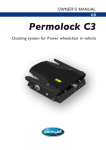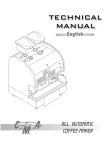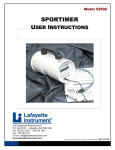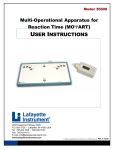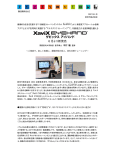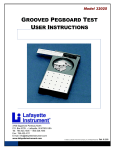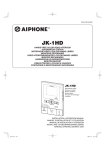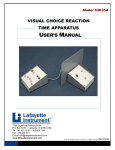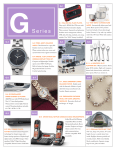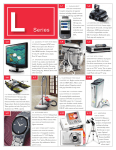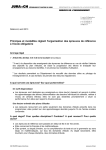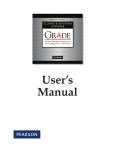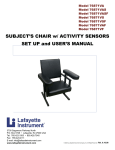Download THE MINNESOTA DEXTERITY TEST - Meetinstrumenten in de zorg
Transcript
MODEL 86070 USER’S MANUAL Model 32023 THE MINNESOTA DEXTERITY TEST Examiner’s Manual 3700 Sagamore Parkway North P.O. Box 5729 • Lafayette, IN 47903 USA Tel: 765.423.1505 • 800.428.7545 Fax: 765.423.4111 E-mail: [email protected] www.lafayetteinstrument.com Fax: 765-423-4111 . www.lafayetteinstrument.com . E-mail: [email protected] THE MINNESOTA MANUAL DEXTERITY TEST (MMDT) #32023 CONTENTS PREFACE Introduction Theory and Application ADMINISTRATION Timing Test Batteries Practice Group Testing Supplies Needed TEST PROCEDURES General Instruction Placing Test Turning Test SCORING AND INTERPRETATION OF DATA TECHNICAL DATA REPLACEMENT PARTS AND REORDERING INFORMATION Frequency Distributions Technical Tables APPENDIX A Group and Individual Norms Based on Older Adult Unemployed Types of Interpretation Scales Norms INTERPRETATION CHART APPENDIX B Group Placing and Turning Tests Norms For Young Adults REFERENCES 3 3 3 3 4 4 4 4 5 5 5 6 7 8 10 10 11 12 13 13 13 13 14 15 15 16 Test Administrator’s Manual Revised Edition 1998 Physical and Occupational Therapists use the MMDT for injury rehabilitation. The MMDT is a tool used to obtain baseline data on a patient. This test can also be used to document patient progress and/or degree of disability. PREFACE Introduction The Minnesota Manual Dexterity Test (MMDT) is a frequently administered, standardized test for the evaluation of a subject’s ability to move small objects various distances. This manual is a guide demonstrating the proper test procedure for each test battery. The test administrator must read and follow the manual completely to insure that standardization has occurred and that the test results are accurate. Note: Failure to follow the manual may affect the subject’s test scores, making the test invalid. Vocational evaluators use the MMDT to determine a subject’s ability and aptitude for certain workrelated applications and for recommending job placement that requires manual dexterity. The MMDT is also used to develop a specific training program that will give an individual the skills to complete a job task that requires manual dexterity. Human Resource Directors and Temporary Staffing Agencies use the MMDT as a pre-employment screening and selection tool. An applicant’s performance on the MMDT can indicate their ability to perform in a job/task that requires manual dexterity. Note: It is strongly recommended that the testing organization show a correlation between a subject’s performance on the MMDT and a subject’s performance in the specific job task. This may be accomplished by testing subjects currently working in a specific job task who are high performers and low performers. Then test the same subjects using the MMDT. The high performer should score higher on the MMDT than the low performers. Theory and Application The Minnesota Manual Dexterity Test (MMDT) is used to measure a subject’s simple but rapid eyehand coordination as well as arm-hand dexterity. In general, the MMDT measures gross motor skills. Gross motor skills involve the movement of large musculature and a goal where the precision of movement is not as important to the successful execution of the skill as it is for fine motor skills. (Magill, 1989, p.11) Many approaches have been developed to classify motor skills. Each classification system is based on the general nature of the motor skills relating to some specific aspect of the skills. Magill (1989) considers three systems, in which motor skill classification is based: 1. the precision of the movement 2. defining the beginning and end points of the movement 3. the stability of the environment The MMDT incorporates all three of these systems. ADMINISTRATION Before administering the MMDT, the test administrator is advised to carefully read this section of the manual. As with any standardized test, it is important to follow the directions very closely. If the MMDT is to be used as a basis for employee selection, the test must be administered to all applicants according to the standardized test procedure. If the test is not given identically, irrelevant factors may affect test scores. In order to reduce the variability among test administrators, specific details regarding the arrangement of materials and the testing procedures are presented below. The MMDT can be used for many testing applications. Physical Therapy, Occupational Therapy, vocational evaluation, and pre-employment screening are four generalized uses of the MMDT. Other applications for the MMDT can be found by doing a bibliography search. 3 The test administrator is advised to practice the administration of the MMDT before giving it for selection purposes. The amount of practice needed in order to become comfortable with the testing process is dependent upon the test administrator's previous testing experience. The test administrator should practice the MMDT until he or she is able to perform each of the tests at an above-average speed for demonstration purposes. Note: The test administrator will be demonstrating to the test subject what is expected of him or her before each test. BOLD Italics and are framed in “quotation marks”. Make sure to read through the directions to ensure that they are clearly stated to the test subject. Remember: Ask the test subject if they have any questions about the test. Practice One trial should always be given for practice. Note: The test administrator should demonstrate the test to the subject before starting the practice trial. Four test trials in addition to the practice trial are highly recommended. The fewer trials administered, the less test score reliability. For individual testing, norms are provided for interpreting a total score based on two, three or four test trials. Group testing norms are based on three and four test trials only. Timing When using an ordinary watch or wall clock, it is recommended that the test administrator say the word “READY,” pause, and then say “GO” at the instant that the second hand reaches a landmark point on the clock. For example, the test administrator may want to start on one of the fivesecond marks. Make sure to pick a starting point on the clock that is easy to read. After the test administrator says, “GO,” immediately write down the subject’s starting time in minutes and seconds. As soon as the subject finishes, record the finishing time above the beginning time and calculate the difference by subtracting. This calculated number is the subject’s test score. Note: 2 minutes and 30 seconds = 150 seconds. Scoring is interpreted by total seconds for any given number of trials. Group Testing If the MMDT is to be administered to a group, the test administrator should demonstrate the test on a separate board located in front of the subjects as he or she reads the directions to the group. Figure 1 on page 3 illustrates one arrangement that permits the test administrator to oversee the testing of many subjects during group testing. Tip: GROUP TESTING promotes competition among peers, which is good when testing a subject’s ability to manipulate objects as quickly as possible. However, an individual CAN do just as well when tested individually, but he must be appropriately motivated. Motivation given by the test administrator is encouraged and necessary. Without appropriate motivation, the subject is apt to loaf along and thus not earn a score that demonstrates the subject’s true potential. Overall, there is greater reliability in a group testing situation, even if only two subjects are in the group. Test Batteries The MMDT includes instructions for 2 test batteries: 1. Placing Test 2. Turning Test The Placing Test and the Turning Test are commonly administered test batteries. Each test battery is listed in the next section separately. The directions are presented in a step-by-step format. All directions the test administrator reads to the subject are printed in 4 3) Stopwatch or clock that reads in seconds. A stopwatch or interval timer is highly recommended, especially for group testing. Tip: When you are using an ordinary watch or wall clock, please read the paragraph in the ADMINSTRATION section of the manual that offers further instructions concerning start and stop times. TEST PROCEDURES General Instruction The test administrator should have the MMDT in the starting position on the table before the arrival of the subject. Note: All subjects must stand during the duration of the test trials. The score sheet should be placed on the table directly in front of the test subject. When the subject(s) arrives and is standing comfortably in front of the table, say: Figure 1 This picture shows an example of an optimal group testing arrangement. Note: The test administrator should be able to observe all test subjects. “You must enter your name, the date, and your dominant hand in the spaces provided on the score sheet. Today’s date is _____________. Do not fill out any other part of the form.” Give an overview of the MMDT by saying: Special Group Instructions are in a box on page 4. Supplies Needed “The series of tests that you are going to take will measure your eye-hand-finger coordination and gross motor skills. The tests are timed, so you must complete each as quickly as you can.” You will need the following supplies or items in order for the Minnesota Manual Dexterity Test (MMDT) to be a consistent, standardized test: 1) Minnesota Manual Dexterity Test #32023 a. Instruction Manual b. 1 test board c. 60 black and red plastic disks d. Tablet of score sheets. Now administer the first test to be given in the series. model Special Group Instructions: If the test administrator determines that the subjects should enter their own times on the score sheet, then the following directions must be read to the group: 2) Testing table that should be between 28 and 32 inches in height. Note: The subject will stand at the table throughout the administration of the MMDT. “On the score sheet, there are some spaces you will use to write in the time it takes you to complete each test. Notice that there are 5 sections and that the sections have boxes that say “Practice Trial," 5 “The object of this test is to see how fast you can put the disks into the holes of the board using only one hand. You will want to use your dominant hand.” 'Trial 1,” "Trial 2," "Trial 3,” and “Trial 4.” As you are finishing each test, I will be counting the seconds aloud like this: 55, 56, 57, 58, and so on. I want you to write down the number of seconds that you hear me say just as you finish each trial. I will tell you where to write the number before you begin each trial. Now, put the pencil and score sheet to one side making sure that it is out of your way.” Demonstrate as you read the following instructions. Note: If you are facing the subject across the board, remember to demonstrate on your LEFT because the instructions pertain to the subject’s RIGHT. Also remember that TOP to the subject is BOTTOM to you. You should start your demonstration slowly and increase speed as you speak. Tip: As the first subject is near the end of the practice trial, you should read the number of seconds aloud as an example to the subjects of what they should expect to hear. For every trial during each test, you must show the group where they should enter their times in seconds onto the score sheet. “You must begin on your RIGHT. Pick up the bottom disk and insert it into the top hole of the board. Now, you must pick up the next disk in the column on the right, and so on. You will move from right to left on this test. Once you complete one column, repeat the previous sequence in the second column until you have filled the entire board.” Placing Test Starting Position. Put the board on the table about 10 inches from the edge. Insert the disks into the holes in the board. Lift the board UP, allowing the disks to fall through the holes and remain in straight rows and columns on the table. Now place the board directly in front of the disks. Note: If the disks moved out of place, manually realign the disks. The board should now be about 1 inch from the edge of the table closest to the subject. This is the starting position for the placing test. Figure 2 illustrates this position. Continue demonstrating until two columns have been filled. Now, remove the eight disks from the board and put them back into place above the board. Note: You may have to use a ruler or an object with a straight edge to align the disks properly. “You may hold the board with your free hand if you wish to do so. Do you remember the order in which you pick up the disks and place them down?” If the instructions must be repeated, point to the disks in the order that they should be picked up and then point to the disks in the order that they should be placed into the holes in the board. “You must make sure that all of the disks are fully inserted into the holes of the board before the trial is complete. If you dropped a disk, you must pick it up and insert it into the proper hole before the time is stopped. Your score will be the total number of seconds it takes to complete several trials. We will record the time for each trial Figure 2 Starting position for the Placing Test. Begin by saying and demonstrating: 6 separately. When you finish one trial, we must rearrange the board and disks into the starting position before starting another trial. Please do not touch the disks until you hear further instruction.” If you are going to give another test, you should let your subject know that he or she will be taking a different test now. At the completion of the Placing Test, the board and disks should be in the correct starting position for the Turning Test . Start the stopwatch or log the time as soon as you say the word, “GO.” During the practice trial, you can provide assistance to the subject if necessary. Turning Test Starting Position: Put the board on the table about 1 inch from the edge closest to the subject. Insert all of the disks into the holes in the board with either the RED or BLACK side facing UP (the color must be consistent on the whole board). You should now be in the starting position for the Turning Test, which is illustrated below in Figure 3. You will now begin the first trial by saying: “Put your hand on the first disk. READY, GO!” When the subject is finished with the trial, log the time in seconds in the space provided on the score sheet. Now, you must move the board (now filled with disks) to the top. Lift the board UP, allowing the disks to fall through the holes. Now place the board directly in front of the disks. Remember: The board should be about on 1 inch from the edge of the table. The board should now be in the starting position for the next trial of the Placing Test. You can begin the next trial by saying: “Put your hand on the first disk. READY, GO!” Repeat the above procedure until all of the desired trials are completed. You should encourage the subject between every trial by stating the appropriate sentence: Figure 3 Starting position and sequence of rows with directions of travel for the Turning Test. “Remember, you are being timed, so complete each trial as quickly as possible.” “The object of this test is to see how fast you can pick up the disks with one hand, turn them with the other hand, and replace the disks back into the holes on the board.” Begin by saying: Or, “You did a good job, but I believe that you can complete the next trial faster.” You should start your demonstration slowly and increase speed as you speak. Figure 3 illustrates the sequence of rows and the direction of travel in the Turning Test. Note: If you are facing the subject across the board, remember to demonstrate on your LEFT because the instructions pertain to the subject’s RIGHT. Also remember that TOP to the subject is BOTTOM to you. Demonstrate as you read the following instructions. And on the last trial, “This is the last trial and should be your best time.” At the end of the last trial, you will say: “That’s all for this test.” 7 “With your LEFT hand, pick up the block from the upper right-hand corner. Turn the disk while passing it to your RIGHT hand and return it into the original hole in the board with the BOTTOM side facing UP. You must work to your LEFT across the board on the top row.” color on the disks is now exposed. Please do not touch the disks until you hear further instructions.” Start the stopwatch or note the time as soon as you say the word, “GO.” During the practice trial, you can provide assistance to the subject if necessary. You will now begin the first trial by saying: Continue to demonstrate until you complete the entire TOP row. As you start to demonstrate the second row, say: “Put your LEFT hand on the disk in the top righthand corner of the board. READY, GO!” “Now with your RIGHT hand, pick up the first block in the second row. Turn the disk while passing it to your LEFT hand and return it into the original hole with the BOTTOM side facing UP. You will work to your RIGHT until you complete the entire row.” When the subject is finished with the trial, log the time in seconds in the space provided on the score sheet. Remember: The board should be about 1 inch from the edge of the table. You can begin the next trial by saying: The subject always picks UP the blocks with the hand that LEADS and put them DOWN with the hand that FOLLOWS. Continue demonstrating the test in its entirety. “Put your LEFT hand on the disk in the top righthand corner. READY, GO!” Repeat the above procedure until all of the desired trials are completed. You should encourage the subject between every trial by stating the appropriate sentence: “As you work back to the LEFT in the third row, you will use your LEFT hand to pick up the disk and your RIGHT hand to return it back to the original hole. Working back to your RIGHT on the fourth row, you must use your RIGHT hand to pick up the disk and your LEFT hand to return it.” “Remember, you are being timed, so complete each trial as quickly as possible.” Or, “You did a good job, but I believe that you can complete the next trial faster.” You should finish the test at a moderate speed. All of the disks must be turned so the same color is facing UP. The board should now be in the original starting position. And on the last trial, “This is the last trial and should be your best time.” “You must make sure that all of the disks are fully inserted into the holes of the board before the trial is complete. If you dropped a disk, you must pick it up and insert it into the proper hole before the time is stopped. Your score will be the total number of seconds it takes to complete several trials. We will record the time for each trial separately. When you finish one trial, the board and disks should already be in the starting position for another trial. In other words, the opposite At the end of the last trial, you will say: “That’s all for this test.” You have now completed the last test battery of the MMDT. 8 SCORING AND INTERPRETATION OF DATA (AGS, 1969) Interpretation The interpretation of MMDT scores is most appropriately based upon results from prior use of the test in specific selection applications. As pointed out in a previous section, Human Resources Personnel usually wish to classify job applicants into categories. The question then arises: How high or how low must a subject score be to place in one category rather than another? The answer to this question establishes a critical score. For example, an employer may decide that he will employ for certain types of jobs, applicants who score at or above the 75th percentile point and that he will not employ applicants who score below this. He has, by this decision, set the 75th percentile point as the critical score. Scoring The score on any test of the Minnesota Manual Dexterity Test (MMDT) is the total seconds required to complete the chosen number of test trials. Two, three or four test trials may have been administered. The practice trial time is not included in the total score. Composite and comparative scores When the scores of an individual on two or more different tests are to be combined into a composite (sum or average) score, raw scores must first be given a scale value. This can be done by reference to one of the scales at the left side of the chart in Appendix A or B. This must also be done when the difference in score on two tests is to be interpreted, i.e., when one wishes to judge whether an examinee made a better score on one test than on another. This is a major function of the norm charts, for the relative value of scale scores shows visually which are the better and poorer test scores for a subject. The primary function of the norm chart is to assist users in dealing graphically with the scores of an individual as sums, differences and averages. The charts are not designed to furnish a final basis for establishing critical scores. How such a decision was reached is an important matter, but the norms presented in Appendices A and B constitute an insufficient basis for such action. If applicants are plentiful, an employer can, of course, arrange them in such an order that the one scoring highest is at the top, the one scoring lowest is at the bottom and the others range between these two extremes. He then can fill his vacancies from the top of such a list--unless it should turn out that the most successful employees lie somewhere between two critical scores, or that they possess a certain pattern of abilities. Such is often the case. Critical scores can be established systematically and accurately. A good procedure for doing this is to test all applicants routinely and then provide for a follow-up study. From the follow-up study, certain employees eventually can be classified into two categories--satisfactory and unsatisfactory, based upon actual performance on the job. Study of the test scores made by these two contrasting criterion groups will indicate which tests may justifiably be used and what critical scores make possible the most accurate prediction. Personnel selection then is established on a sound and practical basis. Gilbert L. Betts, quoted in 1946 said: Attention is invited to the point of view presented in this manual that norms do not contain critical scores. These scores must be established by users in accord with their particular needs; and that the main function of norms is to equate central tendencies and measures of dispersion among the several tests. By their use the score a subject makes on one test can be compared accurately with the score he makes on any other test. (AGS, 1969, 4) 9 the Two-Hand Turning and Placing Test. Two trials were administered for each test. TECHNICAL DATA (AGS, 1969) Frequency Distributions Table 2 presents the correlations between the four MMDT tests and the success criterion. In addition to Jurgensen's data, Table 2 includes validity coefficients corrected for attenuation. Using the correlation coefficients in Table 2, a multiple R of 0.61 between two of the tests (Turning and One-Hand Turning and Placing) and the criterion was obtained. The nature of the frequency distributions that may be expected by administering the MMDT to a cross-sectional population-sample is illustrated by Figures 4 and 5. These distributions were accumulated in the period just prior to 1933 by administering the tests to employed and unemployed persons. The tests were administered as group tests. The norms presented in Appendix A for group testing are derived from these distributions. Intercorrelations The intercorrelations among four of the tests are reported in Table 3. Reliability Correlation with Another Motor Skill Test Jurgensen (1943) determined reliability on four tests of the MMDT by correlating time on first and second trials and correcting with the Spearman-Brown formula. These results are presented in Table 1. Table 1 also includes estimates of the reliability of two-trial and four-trial tests based on Jurgensen's data. Table 4 reports correlations that have been obtained between two tests of the MMDT and the Pennsylvania Bi-Manual Worksample (Roberts, 1945). REPLACEMENT PARTS AND REORDERING INFORMATION Validity A report by Jurgensen (1943) concerns the use of the MMDT in a corporation that manufactures pulp, paper and paper specialties. The group tested was composed of men hired as converting machine operators in the paper mill. The work required occasional machine adjustments, but consisted chiefly in removing a specified number of tissue paper sheets from the machine, raising the top sheet to insert advertising material, and placing the package of sheets on a conveyer. All were right-handed, high school graduates, aged 18 to 31 years. Three supervisors independently rated each worker on a scale of 5. Ratings were converted to T-scores, and the sum of the three T-scores was used as the criterion of success. The reliability of the criterion measure, estimated by the Spearman-Brown formula, was 0.75. The four tests administered were the Placing Test, the Turning Test, the One-Hand Turning and Placing Test and We at Lafayette Instrument Company continue our service after the sale by offering the following replacement parts for the MMDT: Disks……………………..# 32031 Board…………………….# 1-04811 Manual…………………...# MAN185 Score Sheets……………...# 32032 We can be contacted from 8:00am -5:00pm Monday through Friday for pricing and ordering. 3700 Sagamore Parkway North Lafayette, IN 47904 USA Phone 765-423-1505, Fax 765-423-4111 USA Toll Free 800-428-7545 ext. 207 e-mail [email protected] http://www.lafayetteinstrument.com 10 and 55 are equated to percentile points 31 and 69 respectively. These points represent the maximum and minimum scores made by the middle 38 percent of the normative population. The difference between these two scores approximates the standard deviation (SD) to equal 10, on the standard scale. Furthermore, a standard score of 60 is a score one standard deviation above the mean, and a standard score of 30 is a score two standard deviations below the mean, if the distribution is normal. APPENDIX A Group and Individual Norms Based on Older Adult Unemployed The norms and information presented in Appendix A are taken from the 1946 manual for the Minnesota Rate of Manipulation. These norms are based on the distribution of scores obtained from 3,000 cases tested by the Employment Stabilization Research Institute at the University of Minnesota. The sample was comprised largely of adult, older, unemployed people of the Depression era prior to 1946. The stanine scale is simply the standard scale divided into nine categories. It is useful when punching data into a card to be processed by an automatic sorting machine. Each category in the stanine scale, except the first and the ninth, is bounded by 5-point intervals on the standard scale. The unique feature of the norm chart is the use of several equated scales, so for interpretation purposes, conversion from one to the other is automatic. They are equated on the assumption of a normal distribution. The verbal scale is merely a scale of broad categories. Thus, a subject described as having very high ability would be an individual whose measured ability score falls above 1½ standard deviation (SD) from the mean. A high-ability subject’s score will fall within a range of one SD from the mean. A subject described as having average ability would be an individual whose measured ability score falls within the range of ½ SD above and below the mean. A low-ability subject would fall within the range of one SD below the mean. A subject with very low ability would be an individual whose score falls under 1½ SD below the mean. Types of Interpretation Scales Four scales are aligned on the left of the chart: 1. Percentile scale 2. Standard scale 3. Stanine scale 4. Verbal scale The percentile scale is used when a score on a test is interpreted in terms of percent of the normative population surpassed by a subject making a particular score. The midpoint 50 on the scale is the median, representing that the score made by a subject was better than 50 percent of the normative population. In other words, percentile point 25 represents that a subject performed better than 25 percent of the normative population. Other percentile points are interpreted similarly. Norms In the MMDT Interpretation Chart, the first two columns of norms are used to interpret scores made when the Placing and Turning tests are administered as group tests, and when an examinee is given four trials. All other entries constitute norms for tests administered as individual tests. Separate norms are given for use when the examinee is administering four trials, three trials and two trials. The standard scale is a statistical analysis of a subject's score. It is derived from the normal frequency curve. This curve is bell-shaped and not rectangular like the frequency curve from which the percentile scale is derived. Standard score 50, representing the mean (arithmetic average), is equated to percentile point 50. Similarly standard scores 45 Norms were derived from data furnished by: W. A. Ziegler, Clifford E. Jurgensen, Lindsey R. Harmon John R. Roberts, and Mary Bauman. (AGS, 1969) 13 REFERENCES American Guidance Service (1969). Minnesota Rate of Manipulation Test: Examiner’s Manual. Circle Pines, Minn. Jurgensen, C. E. (1943). Extension of the Minnesota Rate of Manipulation Test. Journal of Applied Psychology, 27, 164-169. Magill, R. A. (1989). Motor Learning Concepts and Applications. Iowa: William C. Brown Publishers. Roberts, J. R. (1945). Pennsylvania Bi-Manual Worksample: Examiner’s Manual. Circle Pines, Minnesota: American Guidance Service. 16 Minnesota Manual Dexterity Test Score Sheet MODEL #32023 Quick Reference Averages (50 Percentile) in Seconds Based on Number of Trials Two Trials* Three Trials* ^ Four Trials* Individual Placing Test 123 183 242 Individual Turning Test 99 146 192 Group Placing Test Not Applicable 155 236 Group Turning Test Not Applicable 124 195 * Data taken from the INTERPRETATION CHART ^ Data found in APPENDEX B for Group Testing averages based on three trials. Subject Record Name: _____________________________ Dominate Hand: Right or Left Reason for Administrating: _________________________________________________ ________________________________________________________________________ Test Administrator Name: _________________________ Test Setting: Group or Test Date:____ /____/____ Individual Scoring Grid Based on Number of Seconds Practice Trial Trial One Trial Two Trial Three Trial Four Total Score A** Score B** Seconds Placing Test Turning Test ** Refer to the INTERPRETATION CHART and choose from the various SCALES. You can use the Verbal Scale, Stanine Scale, Standard Scale, or Percentile Scale. The Verbal Scale and Percentile Scale are the most commonly used. LAFAYETTE INSTRUMENT ACTIVITY WHEEL COUNTER LAFAYETTE INSTRUMENT MINNESOTA MANUAL DEXTERITY Model 32023 Examiner’s Manual Ordering Information: All phone orders must be accompanied by a hard copy of your order. All must include the following information: 1) Complete billing and shipping addresses 2) Name and department of end user 3) Model number and description of desired item(s) 4) Quantity of each item desired 5) Purchase order number or method of payment 6) Telephone number DOMESTIC TERMS There is a $50 minimum order. Open accounts can be extended to most recognized educational institutions, hospitals and government agencies. Net amount due 30 days from the date of shipment. Enclose payment with the order; charge with VISA, MasterCard, American Express; or pay COD. We must have a hard copy of your order by mail or fax. Students, individuals and private companies may call for a credit application. INTERNATIONAL PAYMENT INFORMATION There is a $50 minimum order. Payment must be made in advance by: draft drawn on a major US bank; wire transfer to our account; charge with VISA, MasterCard, American Express; or confirmed irrevocable letter of credit. Proforma invoices will be provided upon request. RETURNS Equipment may not be returned without first receiving a Return Goods Authorization Number (RGA). When returning equipment for service, please call Lafayette Instrument to receive a RGA number. Your RGA number will be good for 30 days. Address the shipment to: Lafayette Instrument Company, 3700 Sagamore Parkway North, Lafayette, IN 47904, U.S.A. Shipments cannot be received at the PO Box. The items should be packed well, insured for full value, and returned along with a cover letter explaining the malfunction. Please also state the name of the Lafayette Instrument representative authorizing the return. An estimate of repair will be given prior to completion ONLY if requested in your enclosed cover letter. We must have a hard copy of your purchase order by mail or fax, or repair work cannot commence. WARRANTY Lafayette Instrument guarantees its equipment against all defects in materials and workmanship to the ORIGINAL PURCHASER for a period of one (1) year from the date of shipment, unless otherwise stated. During this period, Lafayette Instrument will repair or replace, at its option, any equipment found to be defective in materials or workmanship. If a problem arises, please contact our office for prior authorization before returning the item. This warranty does not extend to damaged equipment resulting from alteration, misuse, negligence or abuse, normal wear or accident. In no event shall Lafayette Instrument be liable for incidental or consequential damages. There are no implied warranties or merchantability of fitness for a particular use, or of any other nature. Warranty period for repairs or used equipment purchased from Lafayette Instrument is 90 days. DAMAGED GOODS Damaged equipment should not be returned to Lafayette Instrument prior to thorough inspection. When a shipment arrives damaged, note damage on delivery bill and have the driver sign it to acknowledge the damage. Contact the delivery service, and they will file an insurance claim. When damage is not detected at the time of delivery, contact the carrier and request an inspection within 10 days of the original delivery. Please call the Lafayette Instrument Customer Service Department for a return authorization for repair or replacement of the damaged merchandise. Lafayette Instrument Co. Europe 4 Park Road, Sileby, 3700 Sagamore Parkway North Loughborough, Leics., LE12 7TJ. UK. P.O. Box 5729 • Lafayette, IN 47903 USA Tel: +44 (0)1509 817700 Tel: 765.423.1505 • 800.428.7545 Fax: +44 (0)1509 817701 Fax: 765.423.4111 E-mail: [email protected] E-mail: [email protected] www.lafayetteinstrument.com 3700 Sagamore Parkway North . PO Box 5729 . Lafayette, IN 47903 USA . Ph: 765-423-1505


















